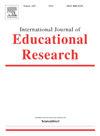大学的横向分层和毕业生工作条件的不稳定性
IF 2.5
3区 教育学
Q1 EDUCATION & EDUCATIONAL RESEARCH
引用次数: 0
摘要
高等教育的全球大众化导致进入劳动力市场的大学毕业生数量显著增加。这种扩张也推动了高等教育机构在声誉、质量和学生背景方面的更大细分。以前的研究主要集中在制度分层和毕业生工资之间的关系上,往往忽视了他们工作条件的其他关键方面。本研究分析智利大学的水平分层与毕业生工作条件的关系。这一目标是通过根据毕业生的工资、招聘制度和工作时间构建工作条件概况来实现的。潜在类别分析用于识别三个不同的概况。通过分析在智利11所大学进行的调查数据,使用有序逻辑模型估计了毕业生特征与工作条件之间的关系。结果显示,尽管拥有大学学位,13%的毕业生在不稳定的条件下工作,包括兼职工作或不保障劳动权利的雇佣合同。虽然制度上的选择性有利于获得最有利的工作条件,但它对其他类型的工作的重要性却在减弱。因此,横向分层作为一种排斥机制,限制了低选择性院校毕业生获得高质量就业的机会。这些发现表明,水平分层和工作条件之间的关系是复杂的,因为它超出了劳动力市场中制度等级的简单复制。本文章由计算机程序翻译,如有差异,请以英文原文为准。
Horizontal stratification of universities and precariousness of graduates working conditions
The global massification of higher education has led to a significant increase in the number of university graduates entering the labor market. This expansion has also driven to greater segmentation of higher education institutions in terms of prestige, quality, and students’ background. Previous research focused predominantly on the relationship between institutional stratification and graduates’ salaries, often overlooking other key dimensions of their working conditions. This study analyzes how the horizontal stratification of Chilean universities relates to graduates’ working conditions. This objective was achieved by constructing profiles of working conditions based on graduates' salaries, hiring regimes, and working hours. Latent Class Analysis was used to identify three distinct profiles. By analyzing data from a survey conducted at eleven Chilean universities, the association between graduates’ characteristics and working conditions was estimated using an ordinal logistic model. The results show that despite holding a university degree, 13 % of graduates work under precarious conditions including part-time jobs or employment contracts that do not guarantee labor rights. While institutional selectivity facilitates access to the most favorable working conditions, its importance diminishes for other types of jobs. Horizontal stratification, therefore, acts as a mechanism of exclusion, limiting access to high-quality employment for graduates from low selective institutions. These findings suggest that the relationship between horizontal stratification and working conditions is complex as it extends beyond a simple replication of institutional hierarchies in the labor market.
求助全文
通过发布文献求助,成功后即可免费获取论文全文。
去求助
来源期刊

International Journal of Educational Research
EDUCATION & EDUCATIONAL RESEARCH-
CiteScore
6.20
自引率
3.10%
发文量
141
审稿时长
21 days
期刊介绍:
The International Journal of Educational Research publishes regular papers and special issues on specific topics of interest to international audiences of educational researchers. Examples of recent Special Issues published in the journal illustrate the breadth of topics that have be included in the journal: Students Perspectives on Learning Environments, Social, Motivational and Emotional Aspects of Learning Disabilities, Epistemological Beliefs and Domain, Analyzing Mathematics Classroom Cultures and Practices, and Music Education: A site for collaborative creativity.
 求助内容:
求助内容: 应助结果提醒方式:
应助结果提醒方式:


